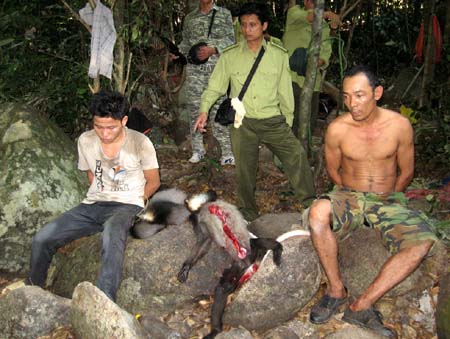
Habitat changes send animals away
Lack of food, conflicts with humans and reductions in number are the things which happen with the elephants in Dong Nai province, the only domestic flock of elephants now residing on the area of 130,000 hectares. According to Bui Minh Tan from the Dong Nai provincial forest ranger unit, the local elephants are facing a lot of dangers.
According to Tan, every elephant individual needs 150 kilos of food, 160-300 liters of water and mineral salt a day. However, the changes of the habitat have led to the depletion of food sources for elephants. As a result, elephants have to move to seek food at residential quarters, where they regularly conflict with people.
The conflicts reportedly happened in the Ta Lai commune of Tan Phu district, Phu Ly and Ma Dai Communes of Vinh Cuu, and Thanh Son, Gia Canh communes of Dinh Quan district. Elephants destroyed sugar cane, cashew, banana, coconut plants, and cassava, rice fields of local residents. Especially, they also damaged people’s houses to seek rice and salt.
Tan has warned that as having the living environment, elephants may die, which will make elephants lose fertility, thus leading to the decrease of the number of elephants.
Not only elephants in Dong Nai province; a lot of other species have also been threatened due to the changes of the habitat. White cheek gibbon, a large primate which is listed as the endangered species in the 2007 Vietnam’s Red Book, is an example. International scientists say that white cheek gibbons now can be seen only in Vietnam and China. Meanwhile, in Vietnam, these gibbons are very few while they are facing the risk of getting extinct.
There are five threats to white cheek gibbons, according to Pham Anh Tuan, an officer of the Thai Nguyen provincial forest ranger unit, including the wildlife hunting, logging, gold digging, land clearing for cultivation and forest fires.
Wave of wildlife extinction?
When the World Wildlife Fund WWF announced the extinction of the one horn rhino in Vietnam, scientists said it is now the right time to ring the alarm bell over the exist and perish of a lot of other species whose names can be found in the Red Book.
The Cat Tien National Park has 40 species whose names are listed in the Red Book. WWF has warned about the possible disappearance of other species at the park, because the flooded forest areas of the Cat Tien National park have been getting dry, which has narrowed the living area of rhinos and other animals.
According to the Ministry of Agriculture and Rural Development, there are 34 rare and precious animal species at the Kim Hy Sanctuary in Bac Kan province, which are listed in the Red Book, including five species which are facing high risks of extinction. The noteworthy thing is that the species facing high risks are mostly located in the forest area of Na Ri district, where people exploit gold.
According to the ministry, no thorough survey has been made, therefore, the list of endangered species at the sanctuary has not completed. The ministry has proposed to carry out deeper research works in the time to come.
In a recent meeting with the press, Dr Le Xuan Canh, Head of the Institute of Ecology and Biological Resources, said that there are 882 species which are facing dangers, an increase of 161 species in accordance with the report released in 1992.
If the situation cannot be improved, in the near future, Vietnam may have to witness the “wave of wildlife extinction” which will cause environmental and economic damages, he has warned.

Leave your comment on this story